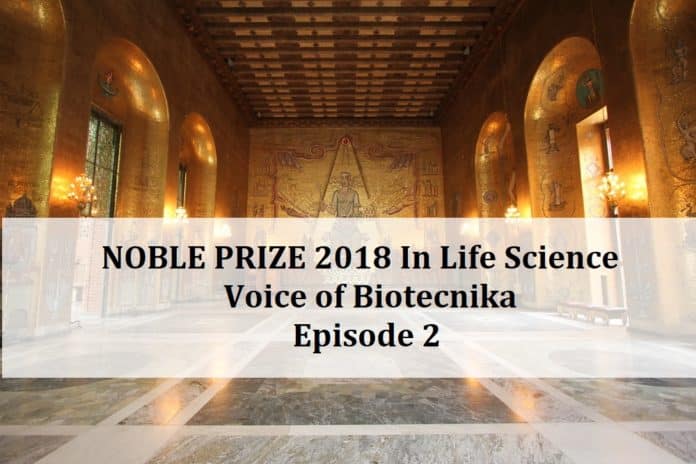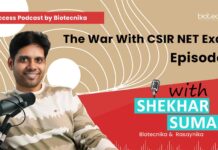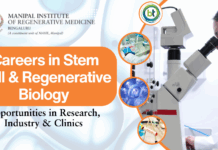Analysis of Noble Prize 2018 – The Voice of Biotecnika, Episode 2
Hello everyone!! Welcome back to Biotecnika’s very own show. I am Rashmi and I bring to you a lot of facts about the recent Nobel awardees in the field of Biosciences.
Out of the 6 fields of Nobel Prize awarded each year, the Nobel Prize given in Physiology or Medicine involves the field of life science. This field has been awarded 108 times so far to 214 Nobel Laureates between the years 1901 and 2017. For the running year, the award has been announced on October 1st, 11:30 AM CEST.
Let us have a look at the work done by Nobel Laureates in the past years.
In 2017, Jeffrey Hall, Michael Rosbash, Michael Young, were awarded the Nobel Prize for their discoveries of molecular mechanisms controlling the circadian rhythm. It signifies the internal biological clock that helps us decipher between night and day and regulates our sleep-wake cycle. The above mentioned 3 brilliant minds together peeked behind the workings of this miraculous system and explained how every organism adapt their biological rhythm to the Earth’s revolutions.
Using fruit flies as a model organism, this year’s Nobel laureates
isolated a gene that controls the normal daily biological rhythm. They showed that this gene encodes a protein that accumulates in the cell during the night, and is then degraded during the day.Subsequently, they identified additional protein components of this machinery, exposing the mechanism governing the self-sustaining clockwork inside the cell. We now recognize that biological clocks function by the same principles in cells of other multicellular organisms, including humans.
With exquisite precision, our inner clock adapts our physiology to the dramatically different phases of the day. The clock regulates critical functions such as behavior, hormone levels, sleep, body temperature, and metabolism. Our wellbeing is affected when there is a temporary mismatch between our external environment and this internal biological clock, for example when we travel across several time zones and experience “jet lag”.
In 1984, Jeffrey Hall and Michael Rosbash, working in close collaboration at Brandeis University in Boston, and Michael Young at the Rockefeller University in New York, succeeded in isolating the period gene. Jeffrey Hall and Michael Rosbash then went on to discover that PER, the protein encoded by period, accumulated during the night and was degraded during the day. Thus, PER protein levels oscillate over a 24-hour cycle, in synchrony with the circadian rhythm.
The next key goal was to understand how such circadian oscillations could be generated and sustained. Jeffrey Hall and Michael Rosbash hypothesized that the PER protein blocked the activity of the period gene. They reasoned that by an inhibitory feedback loop, PER protein could prevent its own synthesis and thereby regulate its own level in a continuous, cyclic rhythm.
The model was tantalizing, but a few pieces of the puzzle were missing. To block the activity of the period gene, PER protein, which is produced in the cytoplasm, would have to reach the cell nucleus, where the genetic material is located. Jeffrey Hall and Michael Rosbash had shown that PER protein builds up in the nucleus during the night, but how did it get there? In 1994 Michael Young discovered a second clock gene, timeless, encoding the TIM protein that was required for a normal circadian rhythm. In elegant work, he showed that when TIM bound to PER, the two proteins were able to enter the cell nucleus where they blocked period gene activity to close the inhibitory feedback loop Such a regulatory feedback mechanism explained how this oscillation of cellular protein levels emerged, but questions lingered.
What controlled the frequency of the oscillations? Michael Young identified yet another gene, double time, encoding the DBT protein that delayed the accumulation of the PER protein. This provided insight into how an oscillation is adjusted to more closely match a 24-hour cycle.
The paradigm-shifting discoveries by the laureates established key mechanistic principles for the biological clock. During the following years, other molecular components of the clockwork mechanism were elucidated, explaining its stability and function. For example, this year’s laureates identified additional proteins required for the activation of the period gene, as well as for the mechanism by which light can synchronize the clock.
In the year 2016 Yoshinori Ohsumi, was awarded the Nobel Prize for work around Autophagy. The word autophagy originates from the Greek words auto-, meaning “self”, and phagein, meaning “to eat”. Thus, autophagy denotes “self-eating”. Ohsumi’s discoveries led to a new paradigm in our understanding of how the cell recycles its content. His discoveries opened the path to understanding the fundamental importance of autophagy in many physiological processes, such as in the adaptation to starvation or response to infection. Mutations in autophagy genes can cause disease, and the autophagic process is involved in several conditions including cancer and neurological disease.
He used Yeast cells as models. Yeast cells are relatively easy to study and consequently, they are often used as a model for human cells. They are particularly useful for the identification of genes that are important in complex cellular pathways. But Ohsumi faced a major challenge; yeast cells are small and their inner structures are not easily distinguished under the microscope and thus he was uncertain whether autophagy even existed in this organism. Ohsumi reasoned that if he could disrupt the degradation process in the vacuole while the process of autophagy was active, then autophagosomes should accumulate within the vacuole and become visible under the microscope. He therefore cultured mutated yeast lacking vacuolar degradation enzymes and simultaneously stimulated autophagy by starving the cells. The results were striking! Within hours, the vacuoles were filled with small vesicles that had not been degraded.
The vesicles were autophagosomes and Ohsumi’s experiment proved that autophagy exists in yeast cells. But even more importantly, he now had a method to identify and characterize key genes involved this process. This was a major break-through and Ohsumi published the results in 1992.
Ohsumi now took advantage of his engineered yeast strains in which autophagosomes accumulated during starvation. This accumulation should not occur if genes important for autophagy were inactivated. Ohsumi exposed the yeast cells to a chemical that randomly introduced mutations in many genes, and then he induced autophagy. His strategy worked! Within a year of his discovery of autophagy in yeast, Ohsumi had identified the first genes essential for autophagy. In his subsequent series of elegant studies, the proteins encoded by these genes were functionally characterized. The results showed that autophagy is controlled by a cascade of proteins and protein complexes, each regulating a distinct stage of autophagosome initiation and formation.
Thanks to Ohsumi and others following in his footsteps, we now know that autophagy controls important physiological functions where cellular components need to be degraded and recycled. Autophagy can rapidly provide fuel for energy and building blocks for renewal of cellular components and is therefore essential for the cellular response to starvation and other types of stress. After infection, autophagy can eliminate invading intracellular bacteria and viruses. Autophagy contributes to embryo development and cell differentiation. Cells also use autophagy to eliminate damaged proteins and organelles, a quality control mechanism that is critical for counteracting the negative consequences of aging.
In 2015, there were 2 prizes awarded in the field of Physiology & Medicine. The first was given to Tu Youyou for working on therapy against malaria, and the second was awarded to William Campbell & Santoshi Omura for their work on discovering novel therapy against roundworm parasite. To learn more about these amazing discoveries please tune in to the next session of Biotecnika’s very own podcast.
Now let us have a look at this year’s greatest contribution benefiting mankind. There were a lot of tough competitors. To name a few we have, the mighty Microbiome, the Cancer-Virus Hunters, Check-point Inhibitors. Our anticipations came to a rest on this October 1st, when James P. Allison and Tasuku Honjo together received the award for their discovery of cancer therapy by inhibition of negative immune regulation.
During the 1990s, in his laboratory at the University of California, Berkeley, James P. Allison studied the T-cell protein CTLA-4. He was one of several scientists who had made the observation that CTLA-4 functions as a brake on T cells. Other research teams exploited the mechanism as a target in the treatment of autoimmune disease. Allison, however, had an entirely different idea. He had already developed an antibody that could bind to CTLA-4 and block its function. He now set out to investigate if CTLA-4 blockade could disengage the T-cell brake and unleash the immune system to attack cancer cells. Allison and co-workers performed the first experiment at the end of 1994, and in their excitement, it was immediately repeated over the Christmas break. The results were spectacular. Mice with cancer had been cured by treatment with the antibodies that inhibit the brake and unlock antitumor T-cell activity. Despite little interest from the pharmaceutical industry, Allison continued his intense efforts to develop the strategy into a therapy for humans. Promising results soon emerged from several groups, and in 2010 an important clinical study showed striking effects in patients with advanced melanoma, a type of skin cancer. In several patients, signs of remaining cancer disappeared. Such remarkable results had never been seen before in this patient group.
In 1992, a few years before Allison’s discovery, Tasuku Honjo discovered PD-1, another protein expressed on the surface of T-cells. Determined to unravel its role, he meticulously explored its function in a series of elegant experiments performed over many years in his laboratory at Kyoto University. The results showed that PD-1, similar to CTLA-4, functions as a T-cell brake, but operates by a different mechanism. In animal experiments, PD-1 blockade was also shown to be a promising strategy in the fight against cancer, as demonstrated by Honjo and other groups. This paved the way for utilizing PD-1 as a target in the treatment of patients. Clinical development ensued, and in 2012 a key study demonstrated clear efficacy in the treatment of patients with different types of cancer. Results were dramatic, leading to long-term remission and a possible cure in several patients with metastatic cancer, a condition that had previously been considered essentially untreatable.
For more than 100 years scientists attempted to engage the immune system in the fight against cancer. Until the seminal discoveries by the two laureates, progress into clinical development was modest. Checkpoint therapy has now revolutionized cancer treatment and has fundamentally changed the way we view how cancer can be managed.
Do let us know on what are your views of this year’s Nobel Laureates. Would you have chosen some other contender? Is there an astounding piece of work that has gone unnoticed? Please leave your message in the comment section below.
While you are at it, I would like to shed light on one more important aspect. Why Indian’s have not been able to be a global leader in this area? Let me recall a few:
- C.V Raman – The Nobel Prize in Physics 1930
- Mother Teresa – The Nobel Peace Prize 1979
- Amartya Sen – The Sveriges Riksbank Prize in Economic Sciences in Memory of Alfred Nobel 1998
- Kailash Satyarthi – The Nobel Peace Prize 2014
- This is fine, but what about the field of Physiology and medicine. In that category we have Indian born, American Laureates like
- Har Gobind Khorana – The Nobel Prize in Physiology or Medicine 1968
- And Ronald Ross – The Nobel Prize for Physiology or Medicine 1902, who was born in Almora, British India
The striking question is though so many aspirants enter into the research world each year, why do we still not have Indian Nobel Laureates recognized for Physiology & Medicine.
When we open this discussion to the audience – we hear about terms like biasness, politics, lack of dedication and unethical reasons. But is it true? Or is it the only reason why we are followers and not leaders. Please feel free to share your views on this.
When we set out to truly discover the underlying truth, we figured that scientists win Nobel Prizes for a single path-breaking discovery. It is all right if he or she hasn’t accomplished anything before or after this breakthrough. A Nobel Prize is not a lifetime achievement award. It is an award for blazing a trail. Nobel Prize winners open up completely new avenues that didn’t exist before.
In order to lead it is essential to think out of the box. We may blame circumstances, but have we really tried our best? From a land which is known for ancient science and physiologies, blaming others seems a lame excuse.
But after Raman, only one other scientist knocked on the Nobel doors hard enough: GN Ramachandran, the outstanding biophysicist who made fundamental contributions to our understanding of protein structure. Ramachandran not winning a Nobel Prize is now considered a significant omission on the part of the Nobel committee, but that is a different matter.
It is our determination and focus that will help us concentrate all our efforts in the projects we do and turn them into unquestionable publications. That is the beginning of a pathway to being a pioneer in the field.
If you find this session interesting and informative, do let us know and leave your valuable suggestions below. Stay tuned with your science partner Biotecnika to learn more about the amazing world of research.











































